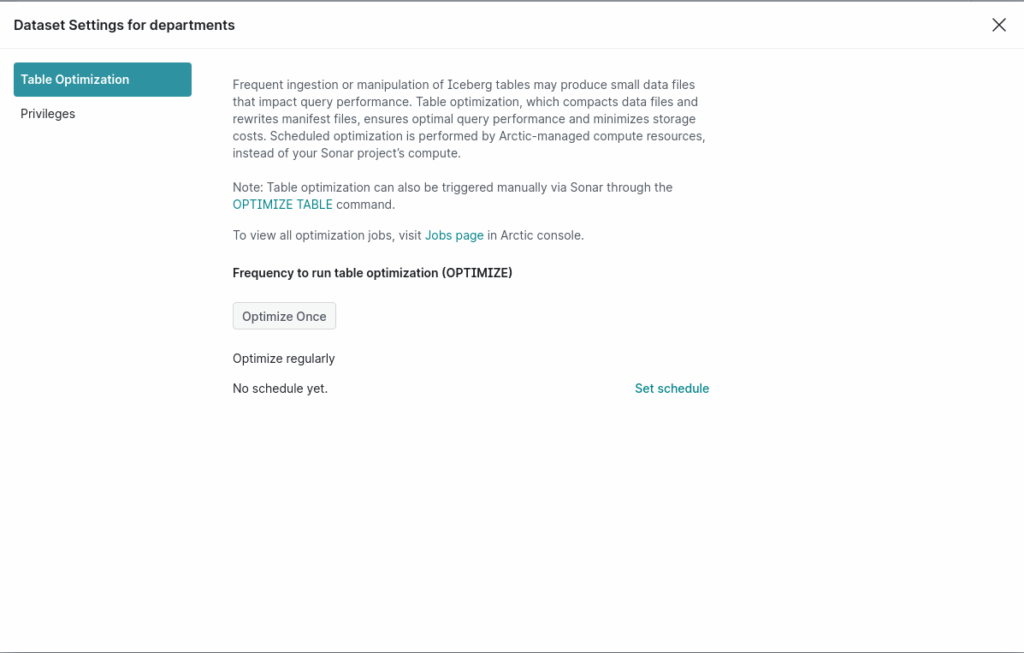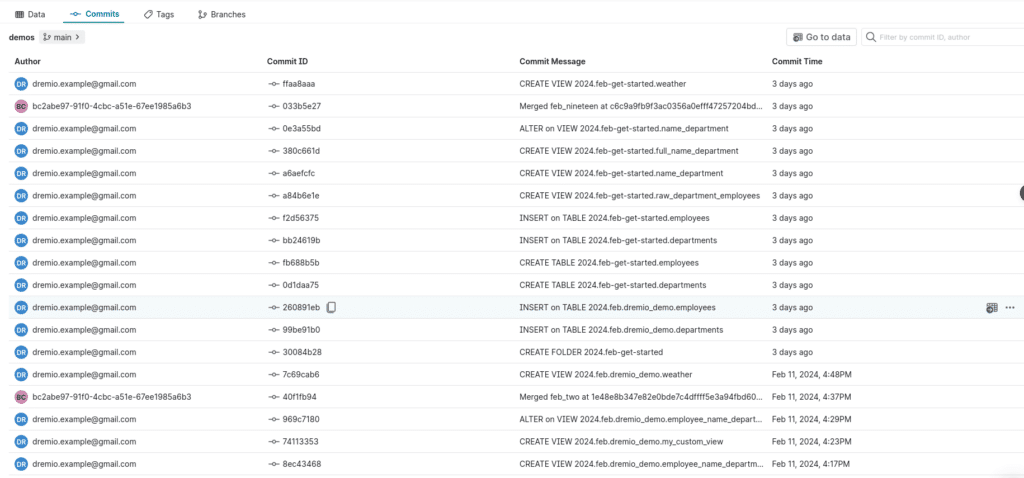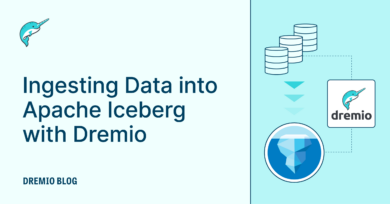11 minute read · February 23, 2024
What is Lakehouse Management?: Git-for-Data, Automated Apache Iceberg Table Maintenance and more
· Head of DevRel, Dremio

The concept of a "data lakehouse" has emerged as a beacon of efficiency and flexibility, promising to deliver the best of both data lakes and data warehouses. However, as organizations rush to adopt this promising architecture, they often encounter a complex landscape of data management challenges. Enter the realm of lakehouse management, a market for tools to help manage lakehouse tables through optimization and cleanup to maintain table performance with only the necessary storage footprint.
Introduction to the Data Lakehouse Concept
A data lakehouse represents a new paradigm in data storage and analysis, aiming to combine the unstructured data capabilities of a data lake with the structured data management of a data warehouse. This hybrid model allows businesses to store vast amounts of raw data while providing efficient tools for querying and analyzing that data. The lakehouse promises a single source of truth for all data analytics needs, reducing silos and simplifying the data architecture.
Yet, managing a data lakehouse is not without its hurdles. Data sprawl, governance, quality, and performance optimization are just a few challenges organizations face. Efficiently managing these aspects requires innovative solutions that can automate and streamline operations, making the data lakehouse a storage solution and an active, manageable environment conducive to insights and decision-making.
Dremio: A Comprehensive Data Lakehouse Platform
Dremio emerges as a leader in this space, offering a comprehensive platform that serves as both a unified analytics engine and an SQL query engine. Dremio's approach is rooted in the philosophy that access to data should be immediate, easy, and without the need for complex ETL processes or the creation of data silos.
Bridging the Gap
Dremio stands out by effectively bridging the gap between the vast, unstructured reservoirs of data lakes and the structured, query-optimized environment of data warehouses. It enables users to perform high-performance SQL queries directly on the data lake, without the need to move or transform data, thus preserving the integrity and immediacy of data access.
Key Features of Lakehouse Management with Dremio
Dremio introduces innovative features designed to address the core challenges of managing data lakehouses. These features streamline data operations and enhance data governance, performance, and collaboration among data teams.
Integrated Nessie-Based Catalog: Git-for-Data
One of the standout features of Dremio's lakehouse management capabilities is its integration with Project Nessie, which brings the powerful concepts of Git to data. This Git-for-Data approach allows data teams to leverage version control practices for their data assets, mirroring the workflows software developers have used for years to manage code.
Benefits of Git-for-Data with Nessie
- Branching and Merging: Data teams can create branches to experiment with data transformations, schema changes, or new data models without affecting the main data sets. This branching model supports agile development practices, enabling more innovative experimentation and safer deployment of changes.
- Commit History and Rollbacks: Every change to the data is tracked, allowing teams to see who made changes, what changes, and when they were made. If a problem arises, it's easy to rollback changes to a previous state, ensuring data reliability and stability.
- Collaboration and Conflict Resolution: The Nessie-based catalog facilitates collaboration across data teams by enabling multiple users to work on different aspects of the data simultaneously. Conflicts can be resolved in a controlled manner, similar to merging code, enhancing team productivity, and reducing bottlenecks.
Here is some example SQL to see how it can be used
-- QUERY TABLE ON MAIN BRANCH SELECT COUNT(*) FROM departments; SELECT COUNT(*) FROM employees; -- CREATE AND SWITCH TO NEW BRANCH CREATE BRANCH feb_nineteen FROM BRANCH main IN demos; USE BRANCH feb_nineteen IN demos; -- INGEST NEW DATA INSERT INTO departments (department_id, name, location, budget, manager_id, founded_year) VALUES (6, 'Customer Support', 'Denver', 400000.00, 6, 2005), (7, 'Finance', 'Miami', 1100000.00, 7, 1998), (8, 'Operations', 'Seattle', 950000.00, 8, 2003), (9, 'Product Development', 'San Diego', 1200000.00, 9, 2015), (10, 'Quality Assurance', 'Portland', 500000.00, 10, 2012); INSERT INTO employees (employee_id, first_name, last_name, email, department_id, salary) VALUES (11, 'Carlos', 'Martinez', '[email protected]', 6, 72000.00), (12, 'Monica', 'Rodriguez', '[email protected]', 7, 83000.00), (13, 'Alexander', 'Gomez', '[email protected]', 8, 76000.00), (14, 'Jessica', 'Clark', '[email protected]', 9, 88000.00), (15, 'Daniel', 'Morales', '[email protected]', 10, 67000.00); -- QUERY TABLES ON ETL BRANCH (Count Reflects new Data) SELECT COUNT(*) FROM departments; SELECT COUNT(*) FROM employees; -- SWITCH TO MAIN BRANCH USE BRANCH main IN demos; -- QUERY TABLES ON MAIN BRANCH BEFORE MERGE (Should have counts without new data) SELECT COUNT(*) FROM departments; SELECT COUNT(*) FROM employees; -- MERGE CHANGES MERGE BRANCH feb_nineteen INTO main IN demos; -- QUERY TABLES ON MAIN BRANCH AFTER MERGE (Now counts reflect new data in production) SELECT COUNT(*) FROM departments; SELECT COUNT(*) FROM employees;
Automated Data Optimization and Cleanup
Dremio simplifies the maintenance of Apache Iceberg tables within the lakehouse through automated optimization and cleanup processes. These processes ensure that data storage is efficient and that access speeds are optimized for analytics workloads.

Key Optimization Features:
- Compaction: Dremio automatically consolidates smaller files into larger ones, improving query performance by reducing the number of files a query engine needs to read.
- Snapshot Expiration: To manage data lifecycle and governance, Dremio provides automated rules to expire and remove old snapshots of tables, freeing up storage space and keeping the data catalog tidy and manageable.
Easy UI for Monitoring Commits and Branches
Managing a data lakehouse requires visibility into the data's history and structure. Dremio's user interface is designed to make monitoring commits, branches, and overall catalog activity straightforward and intuitive.

UI Highlights:
- Visual Branch History: Users can easily navigate the branch history to understand how data evolved over time.
- Commit Monitoring: The UI displays detailed commit logs, including the author, timestamp, and description of changes, making it easier to audit and understand data modifications.
- Simplified Branch Management: Creating, merging, and deleting branches are all simplified through a user-friendly interface, encouraging best practices in data version control and management.
The Impact of Lakehouse Management on Data Strategy
Dremio's management features not only address the technical challenges of data lakehouse architecture but also align closely with strategic business objectives by enhancing data accessibility, reliability, and governance.
Facilitating a Data-Driven Culture
With tools like the Nessie-based catalog and intuitive UI for monitoring data changes, Dremio democratizes data access across the organization. By making data easier to manage and navigate, Dremio encourages a culture of data-driven decision-making, where insights are readily available to inform business strategies.
Ensuring Data Quality and Compliance
Automated data optimization and cleanup processes contribute significantly to maintaining high data quality standards and compliance with regulatory requirements. By automating the management of Apache Iceberg table snapshots and compacting data files, Dremio ensures that data lakes remain performant and manageable, reducing the risk of data sprawl and ensuring compliance with data retention policies.
Accelerating Time to Insight
The agility afforded by Dremio's Git-for-Data capabilities, such as branching, merging, and rollback functionalities, accelerates the data lifecycle from ingestion to insight. By enabling rapid experimentation and collaboration among data teams, Dremio shortens the time required to derive valuable insights from data, thereby enhancing competitive advantage and operational efficiency.
Operational Efficiency and Strategic Agility
Adopting Dremio's lakehouse management features translates into tangible improvements in operational efficiency and strategic agility for organizations navigating the complexities of big data.
Streamlining Data Operations
By automating routine data maintenance tasks and providing a clear framework for data version control, Dremio significantly reduces the operational overhead associated with managing large-scale data lakehouses. This streamlining of data operations allows data engineers and scientists to focus more on innovation and less on maintenance.
Enabling Agile Data Experimentation
The ability to branch and merge data sets safely encourages experimentation, where new ideas can be tested without risk to the production data environment. This agility is crucial for staying ahead in fast-paced industries, where the ability to adapt and innovate based on data insights rapidly can be a key differentiator.
Supporting Scalable Data Governance
As data volumes grow and compliance requirements become more stringent, scalable data governance becomes a critical concern. Dremio's management features support scalable governance by automating data lifecycle management and providing granular visibility into data changes and access patterns, facilitating auditability and compliance.
Conclusion
Dremio's approach to lakehouse management embodies a forward-thinking solution to the challenges of modern data architecture. By integrating Git-for-Data concepts, automating Apache Iceberg table maintenance, and providing an easy-to-use UI for monitoring data catalogs, Dremio not only simplifies data management but also empowers organizations to harness their data for strategic advantage. As we look towards the future of data analytics, platforms like Dremio are paving the way for more efficient, agile, and collaborative data ecosystems.
Learn more about Dremio's Lakehouse Management Features here.
Sign up for AI Ready Data content


